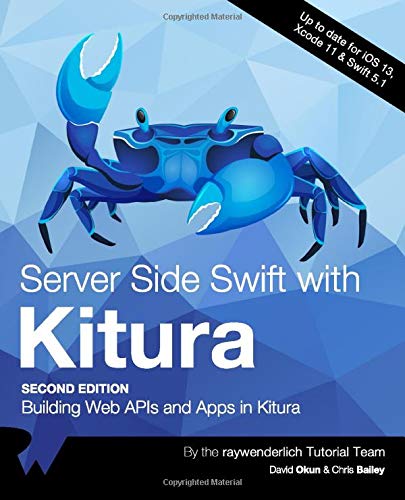
Server Side Swift with Kitura Ray Wenderlich Book Details
Title: Server Side Swift with Kitura
Author: Derek Selander
Publisher: Ray Wenderlich
Language: English
Subject: Swift / Computers & Technology / Programming / Apple Programming
No. of pages: 303
Format: PDF, EPUB, Source code
Recently I bought a set of 2 server side books – Server side swift Bundle from Ray Wenderlich. As you can see in the image above, which includes Server Side Swift with Kitura . And now I want to transfer it to you for $ 15 (2 books) Payment Via Paypal or Bitcoin, All books are the latest version and have full source code, I will share it for you for $ 15 Includes EPUB file and full source code, you can download on Google Drive. When any book have new version i will get it free for you.
LIST SERVER SIDE SWIFT BUNDLE BOOKS:
1, Server Side Swift with Vapor
2, Server Side Swift with Kitura
Please contact me by Email: truonghang0207@gmail.com.
You can see the full description 10 books at https://www.prograbooks.com/2018/05/advanced-swift-bundle-by-ray-wenderlich-html
Thank you
Introduction Server Side Swift with Kitura Books
Welcome! It is awesome that you’ve decided to take a step into the (sometimes) weird and (often) wonderful world of Swift on the server.
Swift as a programming language has grown leaps and bounds since it was announced at WWDC 2014. For developers coming from the world of Objective-C, Swift was a breath of fresh air in a world of square brackets versus dot notation. Swift has certainly experienced bumps along the road to where it is today, but developers who write apps for Apple platforms have largely embraced its modern, streamlined and type-safe approach.
But when Swift made its debut, one thing still stuck out like a sore thumb: Much like its counterpart, Objective-C, Swift was initially confined to the worlds of the Mac and iOS. This meant that a mobile developer writing an app with Swift still had to learn Node, Python or some other server-side language to create a data back end (or find a friend who could write this wizard-like code).
Then in 2015, Apple open-sourced Swift (cue thunderous applause all around). Almost in passing, as he introduced this milestone, Craig Federighi let slip under the radar the tantalizing fact that it was now possible to compile a version of Swift on Linux. The developers who ultimately began principal development on Kitura took notice.
What’s a “Kitura”?
You might wonder about the source of the word “Kitura”. Etymologically, the word Kitura relates loosely to the Hebrew word Keturah, which roughly translates to “incense.” So is this the true derivation of the term? Maybe! It also turns out that there’s a special type of Swift bird called the Chaetura.
When I started working for IBM, the entire team kept me in the dark about this for some time. They went so far as to play an ongoing practical joke — deliberately using different pronunciations of the word each day and playing dumb whenever I pressed for clarity. I finally got to the bottom of this at WWDC 2019, when the co-author of this Server Side Swift with Kitura book, Chris, came clean and let me know that “Kitura” derives from the name of the bird, and that it’s pronounced ki-TU-ra. Mysteries solved!
When Apple announced availability for the Linux build of Swift, IBM quickly pounced. Out of the box, there were major hurdles to overcome: The team worked to port most of Swift’s core APIs, like Dispatch, to compile and pass tests on Linux. In addition to this, the team visualized a module for running a RESTful server using Swift. That module is now known as Kitura.
Why Swift on the server?
The core argument in favor of writing Swift for your server is to share code and knowledge between the front end and the back end of your app. And if you’re a team of one, this streamlining is arguably even more crucial and empowering. This includes, but is not limited to, your model object code.
Given that the team who wrote Kitura came from the Node.js ecosystem, there was a conscious desire to model Kitura after Express.js, which is arguably the most popular Node.js framework for running a RESTful server. There are many facets of Express to discuss, but the router is one of the most important ones. You will learn more about this later in the Server Side Swift with Kitura book. Think of a router as a module that routes requests to the appropriate place. Here is an example of a route in Express.js:
In English, this means that, whenever someone accesses /testing on your server, you send a plain-text response that says “Hello world!” Notice that you have two parameters called req and res passed into your closure for handling the response. Compare this to how a similar route would look in Kitura 1.x:
The two code snippets are nearly identical, except for closure syntax in Javascript versus Swift, and the need to call next() (something they managed to eliminate in Kitura 2.x). Not only does this provide a comfortable landing for Node.js developers interested in trying Swift, but this also means Kitura has been architected with a consistent, tried-and-true methodology that caters to performance, ease of use and code longevity.



